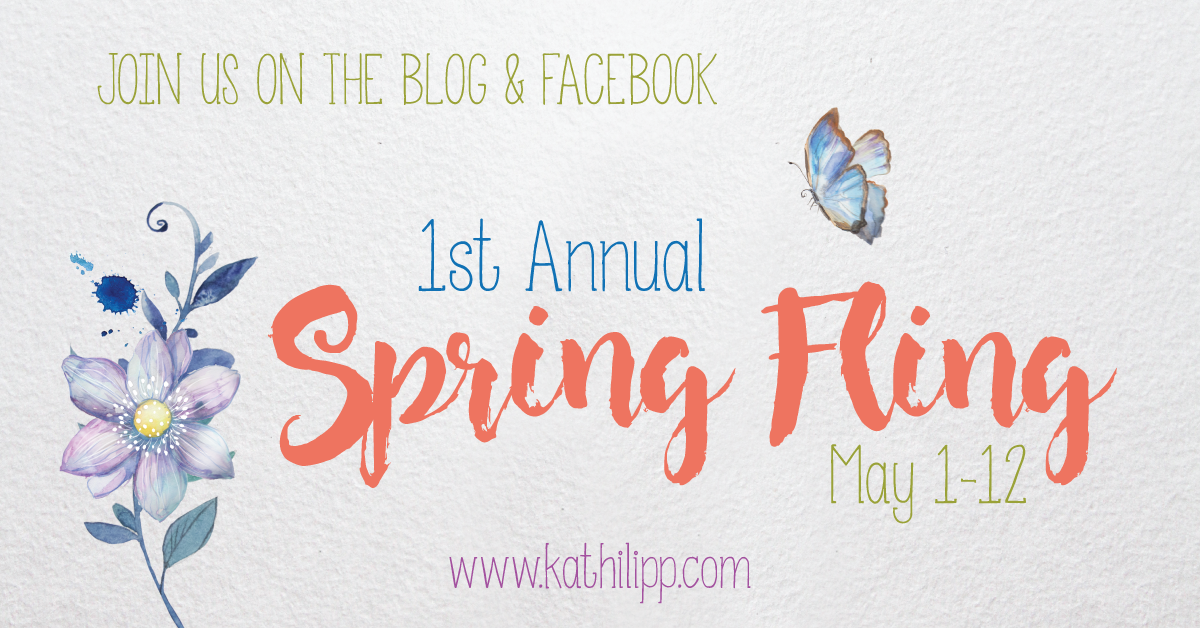
by kathilipp | Apr 29, 2017 | Clutter Free, Spring Fling |

Well, hello, my fellow FLINGERS!
So excited to start flinging with you on Monday! Just a couple of hints as we prepare:
1. We will be taking on one room a day, 20 items a day, over 10 days. If you fling more, great. But even those 200 items will make a difference—not just in your home, but your attitude.
2. Take pictures. Share the love and encouragement by sharing pics of what you’ve done. You don’t HAVE to post a pic, but boy does it get our decluttering juices running.
3. If you get behind, don’t get discouraged. You have the weekend to catch up. We’ll still be here for you!
4. Get your system together. You need one box for Put Away (everything that belongs in that room but is in the wrong place), one box for Give Away (things to be donated or given to a friend), and one box for Other Rooms (anything that goes into another room), plus one bag for garbage and one bag for recycling.
5. Set a timer. See if you can fling your 20 items in 10 minutes. If not, set the timer again and keep going. When you get to 20 items, spend 5 minutes getting all the boxes and bags taken care of.
6. Set up a Give Away Center. This may be the trunk of your car, a place in your garage, or a spot in your shed. Put everything you are giving away in this spot, so it doesn’t get sucked back into the house.
7. Schedule a “Give Away” time each week. For me, it’s Tuesdays when I’m on my way to a church meeting; the donation center is right on the way. I just pull in, unload my car, and give the donation guy a high five.
Set yourself up for success. We are going to have an amazing time over these next 10 days!

by kathilipp | Apr 25, 2017 | Clutter Free, Clutter Free Podcast, Podcast |


In this episode, Kathi Lipp and co-host Erin MacPherson discuss their great ideas for creating summer memories, keeping the chaos at a minimum and planning ahead for a successful time for you and your kids. While we all look forward to the slow-down summer brings, many of us also dread ALL THE HOURS of keeping everyone entertained, educated and active. Kathi walks us through her summer manifesto she used when her kids were still at home and Erin shares her strategies to keeping the kids off the iPad and keeping her sanity as a working mom.
Erin has shared her summer checklist for each of her three kids with us as well. Click here to download.
Kathi ‘s Summer Manifesto provides a great starting point for focusing your summer. The manifesto can be found below in the downloads section.
Kathy and Erin also discuss some great audio books to listen to over the summer.
Erin’s Audio Book Favorites:
Roald Dahl Audio Collection
Every Soul a Star
Miraculous Journey of Edward Tulane
Kathi’s Audio Book Favorites:
Prize Winner of Defiance Ohio:
Cheaper By the Dozen
Chronicles of Narnia
Adventures in Odyssey
Kathi and Erin want you to have a great summer – get some stuff off your checklist, have some fun with your kids, and enjoy the (sometimes) slower pace of summer.
Book Giveaway
Clutter Free Academy is giving away a free copy of the Prize Winner of Defiance, Ohio. Tell us what you do or plan to do over the summer in the comments below in the next seven days. One person will be randomly selected to receive the book.
The book giveaway is only available to US residents.
FREE DOWNLOAD

Download this inspiring and colorful Summer Manifesto by clicking on the image.
Erin MacPherson lives in Austin, Texas with her husband Cameron, her sons Joey and Will and her daughter Kate. She is the author of “The Christian Mama’s Guide Series“, a staff writer for Dun & Bradstreet and a freelancer for publications like Thriving Family Magazine, MOPS MomSense, FamilyLife Magazine, Daily Guideposts and BEMag. She blogs about her life, her kids and her faith at ChristianMamasGuide.com.

by kathilipp | Apr 24, 2017 | Clutter Free, Spring Fling |

OK friends, it seems like we are all in need of a bit of help.
Recently, on my Facebook page, I asked the simple question: “What is your biggest clutter challenge? Your bedroom, kitchen, office, garage?”
The response, was a bit overwhelming to say the least. Here are just a few of the comments:
“Yes, all of it!! With 5 kids that don’t seem to have a cooperative bone in them (at least when it comes to organization and cleanliness), it is all a pit!” – Laura
“Desk. Because everything is ‘important’ and needs to be visible so I remember to do something with it, (she said from 6 feet under…).” – Diane
“Garage! No attic or basement so everything from extra files, books, bikes, tools, holiday decor & clothes (waiting for kids to grow into next size) are in there. It’s truly my nemesis!!” – Laura
“Oh, if I were to be truly honest, it would be my craft stash… yarn, beads, fabric…it totally takes over my office.” – Rita
And finally,
“Let’s be honest….all of it.” – Amanda
So here at Clutter Free we love a good clutter challenge. From the sounds of these responses, it seems like revving up for summer we are all in desperate need of one.
Starting May 1 and ending May 12th we will have our first annual “Spring Fling!” Here’s how it works:
1. Over 10 days, (weekends off to rest or, more likely, catch up,) you will be given one assigned room and instructions of what twenty items to “fling.”
2. We will have a private Facebook group where you can share your victories, get accountability, and share your photos of what you’ve “flinged!”
3. To participate, just make sure you are signed up to receive our blog, and then join our Facebook group.
4. At the end of the challenge, we will be picking a random winner from each day who completed the challenge to receive a copy of Kathi’s book The Cure for the Perfect Life, all about perfectionism, people-pleasing, preformancism and procrastination. (All things that lead to clutter!)
So let’s see, only 10 days and 200 things out of your house? What a great way to head into summer.
Won’t you join us for a Spring Fling? Your house will thank you.
Save

by kathilipp | Apr 18, 2017 | Clutter Free, Podcast |

Kathi and Co-host Erin MacPherson discuss their summer travel plans and how to travel clutter free. Both are taking big trips and need to pack lightly.
Kathi is taking a month sabbatical in celebration of her 50th birthday. She plans to spend 10 days at home and 20 days traveling with lots of R & R (Rest and Roger).
Erin is heading on a road trip with her husband, children, and parents in one SUV. They will be traveling to Florida and then up the eastern coast through Georgia, South Carolina, then across to the Great Smokey Mountains and then to Nashville and back home.
Clutter Free Tips

Kathi’s Suitcase!
They discuss packing tips, using ebags (packing cubes), and how to find great places to stay that feel like home.
If just one or two people are traveling, Kathi recommends AirBnB.
If you have a family and need more room, Erin recommends VRBO. Both places give you the comforts of home (kitchen, laundry, mores space, etc.).
Listen in to learn how to plan your own clutter free travel.
Erin MacPherson lives in Austin, Texas with her husband Cameron, her sons Joey and Will and her daughter Kate. She is the author of “The Christian Mama’s Guide Series“, a staff writer for Dun & Bradstreet and a freelancer for publications like Thriving Family Magazine, MOPS MomSense, FamilyLife Magazine, Daily Guideposts and BEMag. She blogs about her life, her kids and her faith at ChristianMamasGuide.com.

by kathilipp | Apr 11, 2017 | Bible Study, Clutter Free, Podcast |


Clutter Free Bible Study
Clutter Free by Kathi Lipp has changed thousands of lives and now we are going even deeper when it comes to the reasons – the emotional and spiritual reasons – that lie beneath your clutter. In this six-week Bible Study you will, possibly for the first time, truly understand how God wants you to be free. Free from clutter so you can be free to change your world.
Kathi will help you to:
• Break free from the lies that keep you mired in clutter
• Uncover the shame that makes you hold onto things you will never use
• Confront the fear that keeps you down in ‘Just in Case” thinking
• Untangle from the guilt of letting go of things that no longer serve you
It doesn’t matter if you have rooms of clutter at your home or just feel overwhelmed by the constant flow of paperwork in your life, we can all use a friend to guide us through decluttering the distractions that keep us from living out the purpose God has for us. That’s exactly what you will get when you join Kathi for this funny, Bible-fueled journey that’s sure to bring you closer to the One who longs for your heart.
Kathi and cohost, Erin MacPherson discuss the 7 Tips for Decluttering Sentimental Stuff. Kathi has been dealing with her own decluttering project and shows before and after pictures of her pantry.
The Clutter Free Bible Study group has done the top layer of decluttering but is now dealing with the things that have sentimental value or promote guilt. Together they came up with some tips for dealing with the next level of clearing out the clutter.
7 Tips for Decluttering Sentimental Stuff
- Start in the Kitchen There are fewer sentimental items there.
- Put motto on the wall. Keep it visible in a place where you can see it.
- Give it a final goodbye. Take a picture and write a memory about it and then get rid of it.
- Remember when everything is precious, nothing is! You can’t keep everything. Some things you need to enjoy and let it go.
- Keep 3 things per person. Three items that represent each person. Curate what is important and pass the rest on to someone else.
- Don’t guilt others into keeping things.
- Don’t value the past or the future and ignore the present. The clutter of the past or saving things for the future can just crowd out your present life.
Just do little things and start small. Let your house serve your present, not your past or your future.
Kathi’s Pantry Before and After


Erin MacPherson lives in Austin, Texas with her husband Cameron, her sons Joey and Will and her daughter Kate. She is the author of “The Christian Mama’s Guide Series“, a staff writer for Dun & Bradstreet and a freelancer for publications like Thriving Family Magazine, MOPS MomSense, FamilyLife Magazine, Daily Guideposts and BEMag. She blogs about her life, her kids and her faith at ChristianMamasGuide.com.

by Guest Blogger | Apr 5, 2017 | Clutter Free, Guest Blog |
Taming the paper piles
Paper, paper everywhere! Do you have more paper piles in the form of mail, bills, and notes than you know what to do with? Amy has a simple system to help you tame the paper monster.
Today Amy shows you her notebook system she’s used for several years to help tame the paper piles. It was especially helpful when her kids were small, but even now she uses it to organize papers and keep everything she needs at her fingertips.
One Small Win: Make a family notebook to corral your papers.

Amy Carroll is a speaker, writer, and International Initiatives Coordinator with Proverbs 31 Ministries. She’s the author of Breaking Up with Perfect as well as the director and coach of Next Step Speaker Services. Amy and her husband live in lovely Holly Springs, NC with a bossy miniature dachshund. You can find her on any given day texting her two sons at college, typing at her computer, reading a book, or trying to figure out one more alternative to cooking dinner.
Share life with Amy at www.amycarroll.org


















